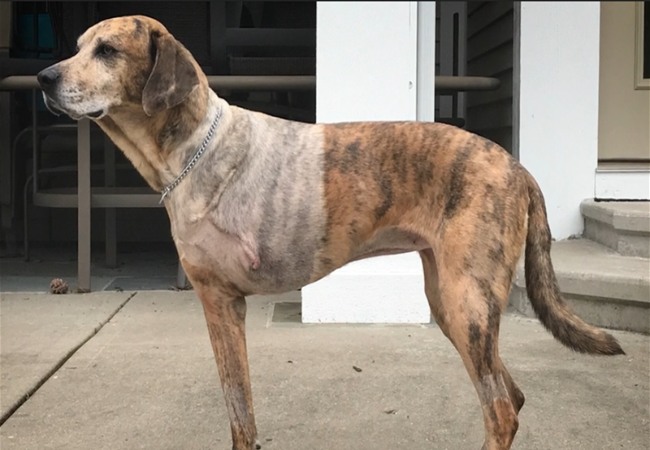Canine Osteosarcoma – Vet Guide 2025 🐾🦴🩺

In this article
Canine Osteosarcoma – Vet Guide 2025 🐾🦴🩺
By Dr. Duncan Houston BVSc
Hello, I’m Dr Duncan Houston, BVSc, founder of Ask A Vet. Osteosarcoma is the most common and aggressive bone cancer in dogs. This 2025 guide explains why it develops, how we diagnose it, and what treatments—from amputation to cutting-edge therapies—can give your pup a fighting chance. We'll also cover care strategies and emotional support to help both of you through this journey. Let’s give your dog the best possible chance. ❤️
📚 What Is Osteosarcoma?
Canine osteosarcoma (OSA) is a malignant bone tumor affecting the limbs, often causing lameness, swelling, or even spontaneous fractures. It accounts for roughly 85% of all malignant bone tumors in dogs, with around 10,000 new cases diagnosed annually in the US.
🐶 Risk Factors & Who’s Affected
- Large/giant breeds: Great Danes, Rottweilers, Irish wolfhounds, Leonbergers—up to 118× higher risk in Scottish Deerhounds.
- Age: middle-aged to older dogs; average age 8–10 years.
- Body size & conformation: Dolichocephalic heads and taller body structure increase risk; chondrodystrophic (short-legged) breeds have lower risk.
- Genetics: breed lines like St. Bernards and Great Danes exhibit hereditary predispositions.
- Neutered status: Neutered dogs show elevated risk compared to intact ones.
🔍 Signs & Diagnosis
- Lameness, swelling, visible bone mass, or sudden pathologic fractures.
- The tumor commonly affects areas “far from the elbow, close to the knee” like the distal radius or proximal humerus.
- Diagnosis requires imaging (x-ray, CT, MRI) and a bone biopsy to confirm malignancy.
🚑 Standard-of-Care Treatment
-
Surgery – Amputation or Limb-Sparing: Amputation removes pain and tumor but requires strong post-op rehab. Limb-sparing surgery can preserve the limb using metal implants, though risks include implant infection.
-
Chemotherapy: Adjuvant treatment with carboplatin, cisplatin, or doxorubicin is common. It can double median survival from ~4.5 months (surgery alone) to 10–12 months, or up to ~12–18 months depending on protocol.
- Radiation Therapy: Often used for limb-sparing candidates or for pain relief when surgery isn't possible. It can shrink the tumor and ease discomfort.
🔬 Novel & Emerging Therapies
-
ECI Cancer Immunotherapy: USDA-approved autologous vaccine and adoptive cell therapy that boosts immune targeting of OSA cells.
-
Oncolytic Virus Therapy: Viral treatment (e.g., VSV-IFNβ-NIS) has shown promise, enhancing 5-year survival rates beyond standard care in trials.
-
Cancer Vaccines & Cell Therapies: Vaccine-primed T-cell therapy and virus-based immunomodulators are under investigation for metastatic disease.
-
Targeted Therapies: Tyrosine kinase inhibitors or anti-resorptive drugs (e.g., bisphosphonates) may help manage bone-associated pain and tumor progression.
- Clinical Trials: Dogs are key to human osteosarcoma research; trials with drug combinations like losartan + standard chemo show encouraging results—with some dogs achieving extended remissions.
📈 Prognosis & Survival
- Surgery + chemotherapy yields median survival times (MSTs) of ~10–12 months; some protocols push to ~12–18 months.
- Surgery alone averages 4.5–6 months.
- Visible metastasis at diagnosis lowers MST dramatically to ~3 months.
- Novel therapies like ECI may further extend quality life, but long-term data is emerging.
- Without aggressive treatment, survival beyond one year is uncommon.
🏡 Home Care & Quality of Life
- Pain Management: NSAIDs, opioids, bisphosphonates, and adjunctive therapies (acupuncture, laser) tailored to your dog’s comfort.
- Physical Support: Supportive harnesses, ramps, padded bedding, and reassurance during recovery from surgery or radiation.
- Emotional Health: Calming enrichment, consistent routines, and gentle exercise as tolerated.
- Nutrition: Balanced diet with omega‑3s and antioxidants to support immunity and reduce inflammation.
- Monitoring: Regular follow-ups with chest imaging and bloodwork to detect recurrence or metastasis early.
✨ Key Takeaways
- Canine osteosarcoma is an aggressive, painful bone cancer most common in large breeds.
- Diagnosis uses imaging (x-ray/CT) and confirmatory biopsy.
- Standard treatment combines limb amputation or limb-sparing surgery with chemotherapy to extend life and minimize metastasis.
- Emerging therapies—like immunotherapies, oncolytic viruses, vaccines, and TKIs—offer hopeful advances.
- With aggressive treatment + care, many dogs survive 10–18 months with good quality of life.
- Home comfort, pain control, nutrition, and emotional support are vital throughout treatment.
If your dog shows lameness, swelling, or bone masses—especially in bigger breeds—don’t wait. Prompt diagnosis and a multimodal care plan can offer months of meaningful, happy time. Reach out to your vet or Ask A Vet for support, and consider specialty care and clinical trials where available. 🩺
🐾 Ask A Vet
- Specialist oncology consults, dog cancer vaccine support, and trial info via Ask A Vet.
Facing osteosarcoma is tough. But with treatment, comfort care, and love, your dog can enjoy quality months filled with joy. We’re here for you—every step of the way. 🐶💖






